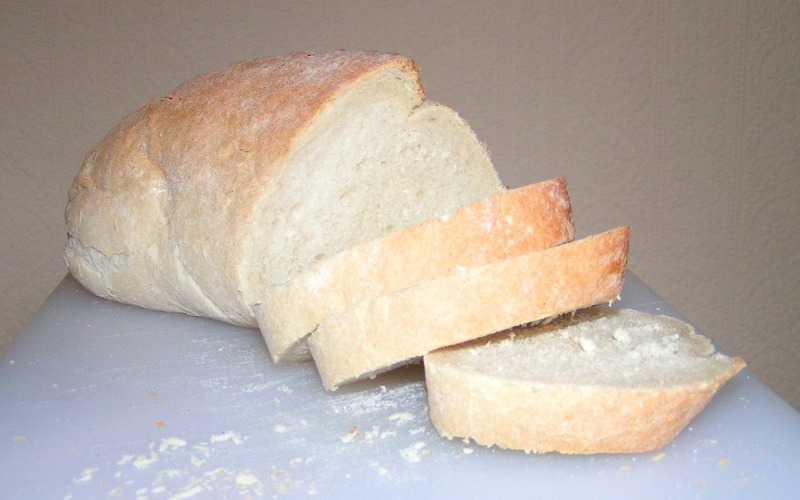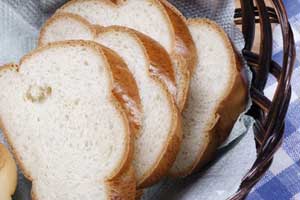
The Case
Against White Flour!
WHITER THE BREAD THE SOONER YOU’RE DEAD!
Most of us are familiar with the term “the whiter the bread the sooner you’re dead!” Ninety eight percent of spaghetti, bread, pastries and pancakes are made from refined white flour. The nutrients which have been robbed from white flour are essential for immune function, cell communication, appetite control, preventingfree radical damage, plus hundreds of other functions in the body.Every time you buy a loaf of ordinary white bread you are taking chances — unnecessary chances — with your health. The average person eats bread but never stops to look behind the loaf. To him or her, bread is bread.
In 1948, a British nutritionist named Lord Mellanby conducted some experiments in which dogs were fed a diet of ordinary white bread. The dogs developed what is mistaken for rabies — shunning food, losing weight, avoiding light, trembling, cringing when patted, falling backwards, howling piteously, and running around madly.
IS BREAD REALLY “THE STAFF OF LIFE?”
Bread has been termed the “staff of life,” but in the form most of us eat this staple, it is piteously weakened stuff. Millions of pounds a year of synthetic food emulsifiers, or “softeners,” are being used in bread, baked goods and other foods, even though the safety for human consumption is questioned.
Refined flour (made from any of the grains) is a devitalized substance. In fact, it contributes to the general degeneration of those who consume it. It has become one of the principal items in the diets of modern men in most countries. There is no way that such devitalized flour can be ‘revitalized,’ ‘enriched’ or in any way improved by the addition of elements needed in nutrition (vitamins, minerals, etc.).
White bread, breakfast cereals, flours—all refined grain products contribute greatly to this nation’s ill-health. Yet studies indicate they make up one-third of the average person’s total carbohydrate intake each day.
THE MADERIA-MAMORE CASE AGAINST WHITE FLOUR
One case against white flour is the Maderia-Mamore case. The Maderia-Mamore Railway Company in 1914 went into the hands of a receiver, after constructing a single track two-hundred and thirty-two miles long connecting Bolivia with Brazil.In the construction of its two hundred and thirty-two miles of track four thousand men were literally starved to death on a white bread diet. Those who escaped death owed their good fortune to the juice of fruits. Most of the victims of acidosis, or as they called the disease in the State of Matto-Grossso, ‘beriberi-‘; are buried in Candelaria Graveyard, three kilometers south of Porta-Velho, midway between that town and Santo Antonio—the district explored by Theodore Roosevelt.
The laborers, of whom there were originally six thousand, consisted of Russians, Greeks, Turks, Italians, Germans, English, Japanese, French, Jamaicans, Barbadians and Brazilians. The officers, engineers and physicians were chiefly British and American.The laborers received the equivalent of $2.40 a day in US currency. They were charged by the Commissary Department an average of one dollar a day for their food. The cost of this food, its inadequacy considered, was so high that it included the lives of the men.
A half-pound tin of glucose jam was sold to them for one dollar. A No. 2 tin of canned sauerkraut sold for one dollar. A No. 1 tin of canned sausages sold for one dollar. The No. 1 tin contained thirteen ounces. The No. 2 tin contained twenty-seven ounces.White bread constituted the chief foodstuff of the men. It was baked in the camp from patent flour imported from the US in thousand-barrel lots, and was furnished by wholesale grocers in New York City under the most highly advertised brands on the market. In addition to the white bread were enormous quantities of hard white crackers and tapioca (acid-forming) made from the root of the native cassava plant. Like farina, cream of wheat, corn flakes, pearled barley, degerminated corn meal and polished rice, tapioca is a refined, denatured, demineralized, high-calorie, acidifying health-destroying food.Supplementing these one-sided units of nutrition were large quantities of lard, coffee, sugar, and macaroni (white flour). A few bags of polished rice were also included.
For breakfast the laborers ate white crackers and white bread with plenty of black coffee, sweetened with sugar. As they had to pay for their own meal, and pay heavily for them they economized as much as possible, believing as most others believe, that bread is the staff of life, and in itself sufficient to maintain strength, energy and health.At noon they ate white bread, white crackers, with more coffee and sugar. Occasionally dried codfish, ham or bacon was substituted. Sometimes they had dried beef.
In the evening the men ate more white bread, crackers, and dried beef and occasionally indulged themselves in a can of sauerkraut, a can of pork and beans, or a can of jam.
The French, Jamaicans and Baradians grouped together, and every day made what the others called ‘sinkers,’ a sort of heavy doughnut composed of white flour, sugar and water, fried in lard.Acidosis (poor blood) under such conditions was inevitable.
The first symptoms observed among the laborers and officers affected were manifested in a tendency to stub their toes while walking along smooth roads. The foot would seem to drag. After that a slight swelling appeared in the ankles, which gradually extended upward to the knees with a loss of sensation. When this swelling was at its height a dent in the flesh made by pressure of the finger would remain for a long time. Shortness of breath and palpitation of the heart, with tremor of the nerves were the next symptoms, after which the men began to walk as though they were suffering from locomotorataxia, with the halting, hesitating, uncontrolled stride characteristic of that disease.
As the cases advanced the swelling subsided, and the leg gradually wasted away, until prior to death nothing remained apparently but the bone and skin.before death all the men were completely prostrated and helpless. None of the drugs with which the physicians were providing had any effect. Finally the doctors ordered ‘no more rice.’ They thought that rice was the bugaboo because they had been reading of the relationship between rice and ‘beriberi.’
As these poor individuals gazed in the direction of Candelaria Graveyard where white flour was to disturb them no more, they might well have chanted, ‘Eventually! Why not now?’ (How many lives have been unnecessarily shortened because of white flour remains to be unseen!)
All refined grains and their products should be eliminated from the diet.
References:
Rodale, J.I., The Prevention Method for Better
Health, Rodale Press, West Kensington, W. 14,
London
Price, Weston A., D.D.S., Nutrition and Physical
Degeneration, Published by the Author, Redlands,
CA
Abbott, George Knapp, M.D., The Witness of Science,
Studies in the Testimonies and Science given at
Pacific Union college
Braly, James, M.D., and Hoggan, Ron, M.A., Dangerous
Grains, Penguin Putnam, Inc. New York, NY
Bad as the bread was in the 1800s and through the mid-
1900s, it became much worse after the end of World
War II. The chemical warfare banned in the war in Europe
was just transplanted to the bakeries of America as the
bread-makers began to slowly poison their customers
with all sorts of new additives, bleaches, and preservatives.
Katy Chamberlin
